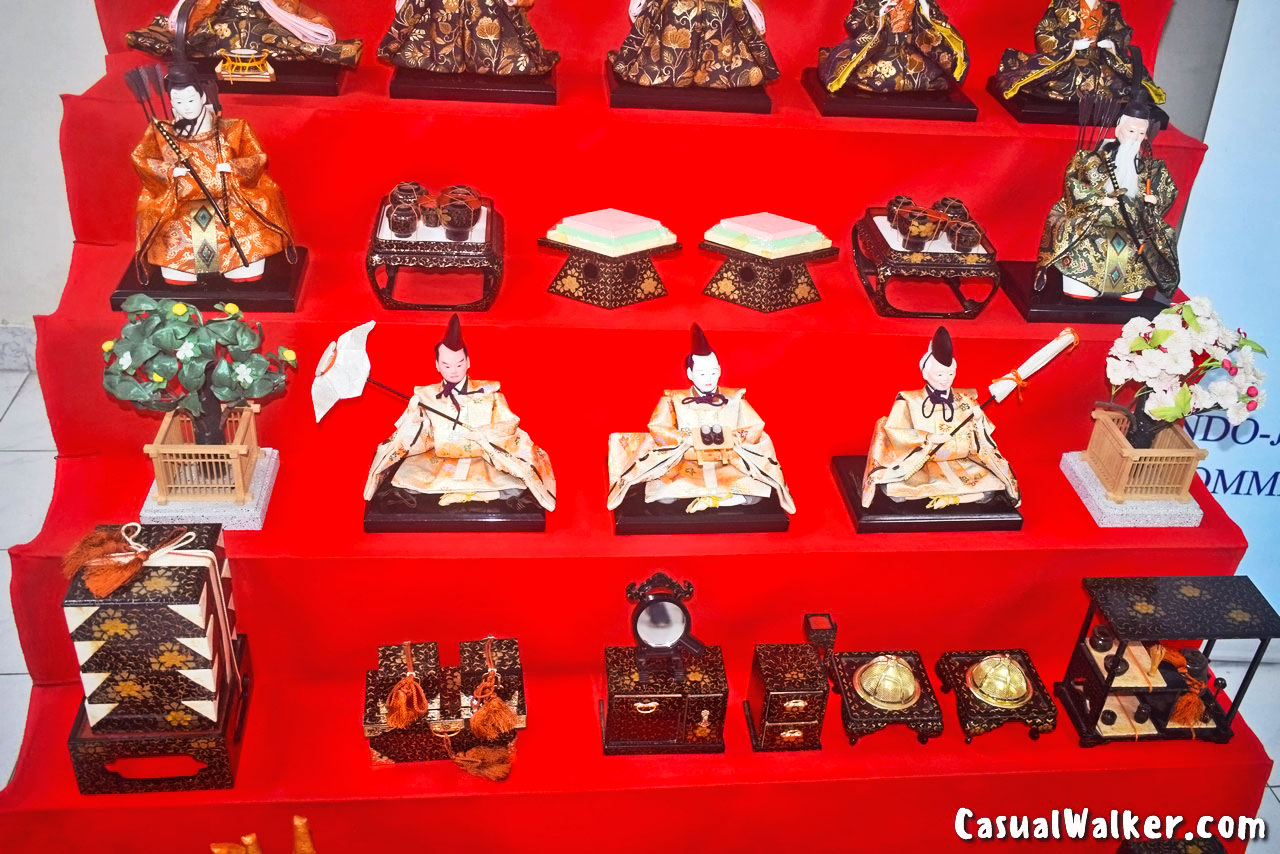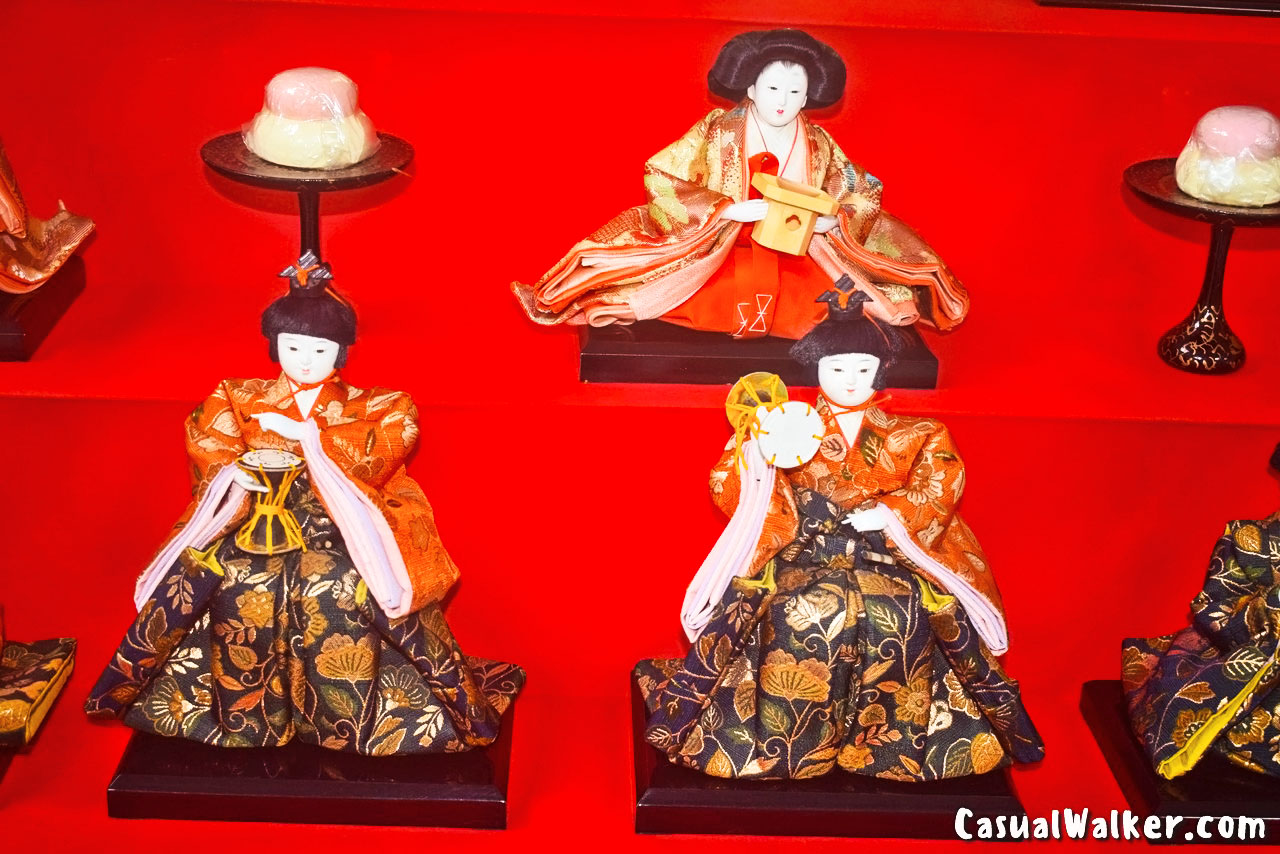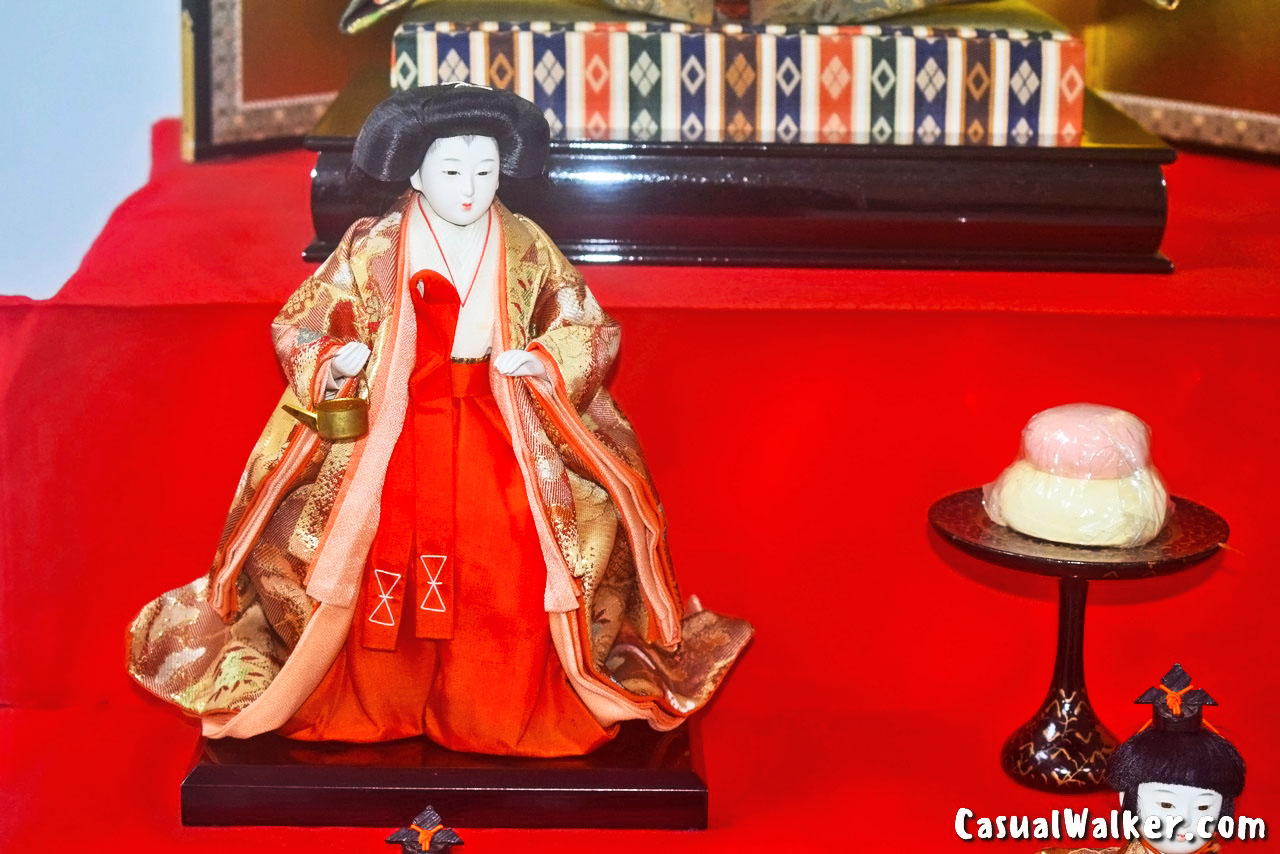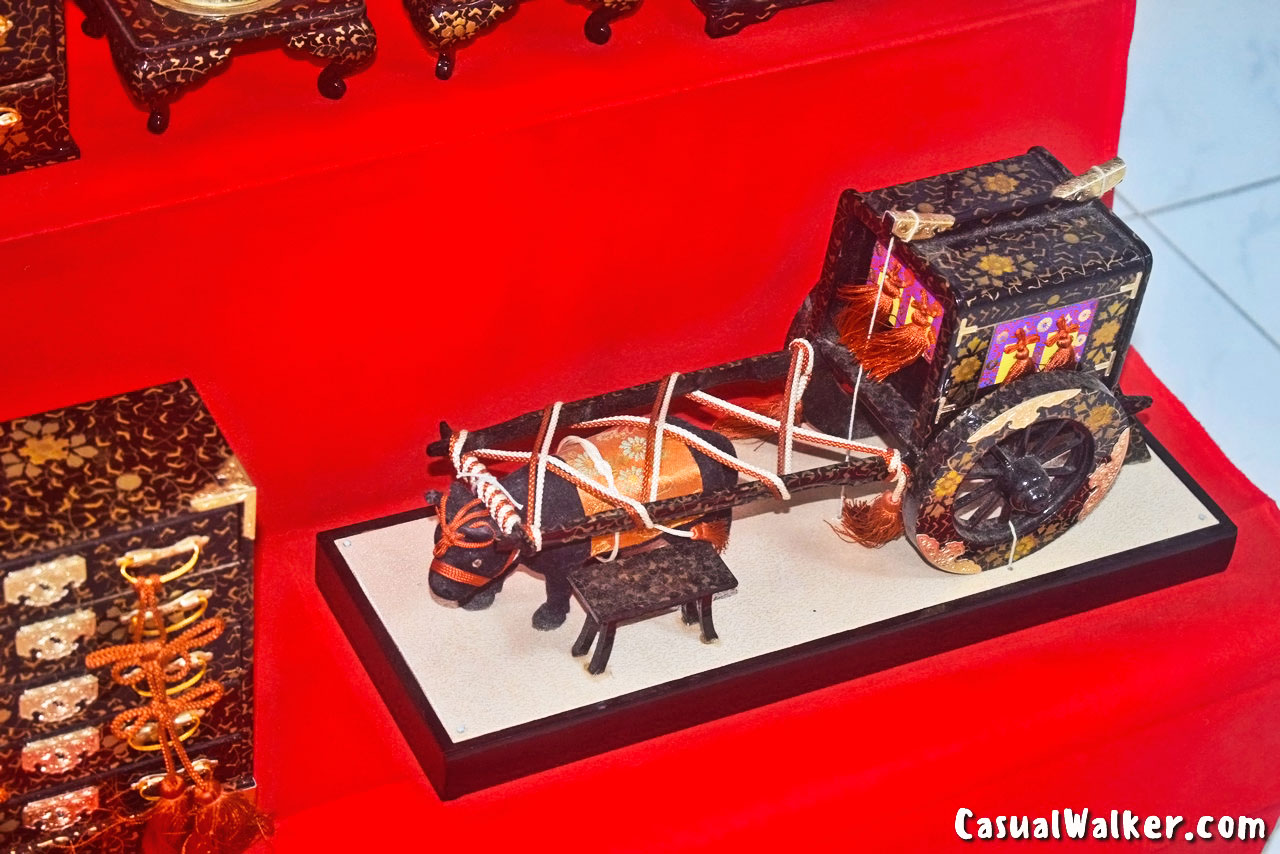Hina-matsuri – Doll’s Day or Girls’ Day, A Japan Doll Festival for Girl’s Health and Happiness – Japan Dolls Exhibition in Chennai & Doll festival Similar to Navarathri / Golu Dolls Festivals in India
– dolls representing the japan emperor, empress, and their court
| CasualWalker’s Rating for Hinamatsuri / Doll’s Day or Girl’s Day Dolls Display, Chennai Exhibition : | |

9.8 – Superb Awesome
|
The famous Japanese festival Hina-matsuri, called the Dolls Day or the Girl’s Day – Japanese Dolls Exhibition was organized by the Indo-Japan Chamber of Commerce & Industry (IJCCI) Chennai and inaugurated by Taga Masayuki san, the Consul General of Japan in Chennai and Nirmala Lakshman, the Chairperson of The Hindu Group.

Why is Hinamatsuri Celebrated?
Hinamatsuri / Hina-matsuri / Hina Matsuri is celebrated in Japan for the health and happiness of young girls. Hina-matsuri are ceremonial dolls, that are handed down from generation to generation as household heritages, and are placed on display in the best room of the house for the duration of the festival, after which they are carefully boxed and stored away until the following year. “Hina” – means dolls and “Matsuri” – means festival in Japanese language.

Hina Matsuri exhibition showcased 15 Hina dolls, which are made of plastic, paper, and silk and arranged on seven levels. It is traditionally celebrated on the 3rd day of March with a display of beautiful dolls as its main feature, was originally a girl’s festival but it is now enjoyed by the whole family.

This is a 1000-year-old custom, where parents who do not possess such heirlooms buy new sets of dolls for any girl-baby born since the preceding festival, and relatives and friends make gifts of dolls. Generally, a set consists of fifteen dolls, usually in ancient costumes. Besides the regulation dolls, the display is not complete unless it includes miniature household articles and appurtenances, which are often exquisite samples of art.

The dolls most highly valued are the Dairi- sama, which represent the Emperor and Empress, dressed in resplendent ancient Court costumes of silk. They are attended by their ministers and other dignitaries, court ladies, and musicians.


History of Hina-Matsuri – the Girl’s Festival
Hina-Matsuri, or Girl’s Festival is celebrated on March 3, when spring is not far off. This is an annual event to pray for the happiness and healthy growth of young girls. On this day, families display Hina Dolls, dressed in traditional court apparel, with peach blossoms and offerings of such delicacies as white sake, diamond-shaped rice cakes, and dry rice-cake pellets. The origins of Hina-Matsuri can be traced back at least several centuries, to three ancient practices. The first involves the traditions of imperial and aristocratic families during the Heian period from 794 to 1185. Dolls were believed to be substitutes for human unhappiness, so children born into nobility played with dolls, dressed in the
court costume of the time.


Display of Hina-Matsuri Dolls
All Dolls are displayed on a doll stand or hina-dan which is a tier of shelves, usually five or seven feet wide covered with bright red cloth. The Dairi-sama invariably occupy the top shelf, the Emperor on the left, the Empress on the right as one faces them.

Behind them are miniature folding screens, which also form a background for decorated toy candle stands and vases with peach blossoms. Court ladies and musicians, ministers, court officials, and delicacies of many kinds in beautifully decorated miniature boxes are placed on the lower shelves.


Peach blossoms also signify the feminine characteristics of softness, mildness, and peacefulness. The daughters of the house and their friends gather before the display and are most ceremonious in their greetings, practicing the rules of etiquette they have been taught.




When the festival is over, the dolls and utensils are carefully packed in wooden boxes and stored away until the festival next year. To open up these boxes, take out the dolls and beautiful furniture, and arrange them on the shelves is a source of great joy to the little girls of the country.


Tango no Sekku – Festival for Boys
This exhibition also displayed a “Kabuto warrior” doll as part of Tango no Sekku – a similar holiday generally celebrated for boys on May 5 in Japan, to instill virtues, such as bravery, discipline, and honor, among boys. This mainly includes a doll of a warrior going to battle.

Hina-matsuri & Navarathri / Golu festivals Similarties
Hina-matsuri is similar to the doll festival – the Navarathri / Golu dolls festivals in India, which showcases a wide range of colorful and beautiful dolls of famous Hindu gods like Lord Siva, Vishnu, Murugan, Vinayaga, Athi varadar, Tirupathi Balaji, and Goddesses Lakshmi, Saraswathi, Kamadhenu, Durga, Sai baba, and many more Hindu god avatars. The Navratri / Dussehra / Dasara is one of the major festivals celebrated for nine days throughout India. Navratri festival is specially dedicated to Goddess Lakshmi, Goddess Durga, and Goddess Saraswathi.

Also, check our Similar Art and Culture Related Photo Stories:
Asuras – Swarna Kolu / Golu, an Indian mythological Dolls & idols Exhibition at Thejus, Chennai
Puppet exhibition by Dhaatu Puppet Theatre, Bangalore / Bengaluru



































7981ti
hello!,I like your writing very so much! percentage we keep up a correspondence more approximately your article on AOL? I need an expert in this house to unravel my problem. May be that is you! Looking forward to see you.
Someone necessarily help to make severely posts I would state. That is the first time I frequented your web page and so far? I amazed with the research you made to create this actual post amazing. Great job!
Yay google is my world beater helped me to find this great website ! .
Great line up. We will be linking to this great article on our site. Keep up the good writing.
I like this site very much, Its a rattling nice spot to read and get info . “A fair exterior is a silent recommendation.” by Publilius Syrus.
I?¦ll immediately clutch your rss as I can not to find your e-mail subscription hyperlink or newsletter service. Do you have any? Please allow me understand so that I could subscribe. Thanks.
Today, I went to the beach with my kids. I found a sea shell and gave it to my 4 year old daughter and said “You can hear the ocean if you put this to your ear.” She put the shell to her ear and screamed. There was a hermit crab inside and it pinched her ear. She never wants to go back! LoL I know this is completely off topic but I had to tell someone!
I enjoy your writing style genuinely enjoying this web site.
Definitely, what a great blog and illuminating posts, I definitely will bookmark your website.Have an awsome day!
Its such as you read my thoughts! You seem to understand a lot about this, like you wrote the ebook in it or something. I think that you simply could do with a few to pressure the message home a little bit, however other than that, this is fantastic blog. A fantastic read. I will certainly be back.
I have read several good stuff here. Certainly price bookmarking for revisiting. I surprise how so much effort you place to create one of these excellent informative website.
naturally like your web site but you have to check the spelling on several of your posts. A number of them are rife with spelling problems and I find it very bothersome to tell the truth then again I will certainly come back again.
Hi, just required you to know I he added your site to my Google bookmarks due to your layout. But seriously, I believe your internet site has 1 in the freshest theme I??ve came across. It extremely helps make reading your blog significantly easier.
I really wanted to make a quick note to say thanks to you for these fantastic suggestions you are showing at this site. My particularly long internet research has at the end been paid with pleasant insight to exchange with my family and friends. I would repeat that most of us readers actually are undoubtedly endowed to live in a perfect site with many perfect people with very beneficial tactics. I feel rather lucky to have encountered the web page and look forward to tons of more amazing times reading here. Thanks once more for a lot of things.
Really well written
https://t.me/s/iGaming_live/4871
Afunjogo, just deposited some money, let’s try our lock. It’s good and smooth, with quick deposits, I like it afunjogo
An impressive share, I just given this onto a colleague who was doing a little analysis on this. And he in fact bought me breakfast because I found it for him.. smile. So let me reword that: Thnx for the treat! But yeah Thnkx for spending the time to discuss this, I feel strongly about it and love reading more on this topic. If possible, as you become expertise, would you mind updating your blog with more details? It is highly helpful for me. Big thumb up for this blog post!
Thanks for another fantastic post. The place else may just anybody get that kind of information in such an ideal manner of writing? I have a presentation next week, and I’m on the look for such information.
Spot on with this write-up, I truly assume this web site wants much more consideration. I’ll in all probability be again to learn rather more, thanks for that info.
I will right away grasp your rss as I can’t in finding your email subscription link or e-newsletter service. Do you’ve any? Kindly permit me recognise in order that I could subscribe. Thanks.
Bei der Big Casino Gameshow haben die Spielkandidaten in den Vorrunden die Qual der Wahl zwischen Boxen und Briefumschlägen. Wir freuen uns auf einen beispiellosen Promiauflauf und die erfolgreichsten Live-Events der deutschen Spielbanken an einem Wochenende.“ Die 62-Jährige ist eine der renommiertesten Schauspielerinnen des Landes und
wirkte in unzähligen Film- und Fernsehproduktionen mit.
Mit dem Publikumsliebling „Big Casino Gameshow“ erleben die Besucher ein elektrisierendes Event.
Bereits verkündet sind zudem Moderatorin Sylvie Meis, TV-Liebling Joachim Llambi und
Schauspielerin Christine Neubauer. Bei Fragen erreichen Sie den Datenschutzbeauftragten der MERKUR GROUP per E-Mail unter
Jetzt entdecken und mitfiebern! Jubiläum der MERKUR SPIELBANK mit Stars, fetten Shows und bester Stimmung gefeiert.
Drei Tage lang wurde das 40. Hier gibt es den exklusiven Recap zum Turnier!
Außerdem kommt Christine Neubauer. Beide gehören zu den berühmtesten Gesichtern des Landes und sind unter anderem durch RTL-Show-Formate
wie „Let’s Dance“ oder „Das Supertalent“ bekannt.
Standortgeburtstag der Spielbank haben sich bereits jetzt hochkarätige Prominente angekündigt.
Das Merkur Casino Bad Oeynhausen befindet sich seit 25 Jahren am
Werre-Park, dem größten Einkaufscenter in Ostwestfalen.
References:
https://online-spielhallen.de/1red-casino-deutschland-eine-tiefenanalyse-fur-spieler/
Die Spielbank Salzburg im Schloss Klessheim, einem Barockschloss in Wals-Siezenheim,
ist eine der Hauptattraktionen für Liebhaber des großen Spiels.
Das Restaurant im Barockschloss Klessheim wurde
2015 neu gestaltet. Mehr zum Automatenspiel Sein Name
und seine europäische Weite in der Baukonzeption bestimmen den künstlerischen Wert des Schlosses.
Das prachtvolle Barockschloss Klessheim vor den Toren Salzburgs
wurde nach den Plänen des berühmten Bauherrn Johann Bernhard
Fischer von Erlach gestaltet.
Während des Zweiten Weltkrieges wurde das Casino geschlossen. Ob Kultur,
Natur oder Genuss – Salzburg bietet dir unvergessliche Erlebnisse.
Für einen kulturellen Ausflug bieten sich die bekannten Festspielhäuser an, die Salzburg zu einem kulturellen Zentrum machen.
Das Restaurant ist bekannt für seine raffinierten Menüs und
die hochwertige Weinauswahl, die den Casinobesuch perfekt abrunden. Regelmäßig finden im Casino auch Pokerturniere und Events statt, die sowohl für Einsteiger als auch für erfahrene Spieler
attraktiv sind. Der Flughafen Salzburg ist nur 5 Kilometer
entfernt und bietet eine schnelle Anbindung. Die empfohlenen Casinos bieten zahlreiche Vorteile und gewährleisten sicheres
Glücksspiel auf höchstem Niveau. Darüber hinaus beherbergt das Casino ein Gourmetrestaurant,
das erlesene Küche serviert und den Ort zu einem umfassenden Unterhaltungsziel macht.
Regelmäßig stattfindende Pokerturniere ziehen Spieler aus aller Welt an und verleihen der eleganten Atmosphäre eine wettbewerbsorientierte Note.
References:
https://online-spielhallen.de/iwild-casino-deutschland-ihr-umfassender-ratgeber/
Das benutzerfreundliche Design der Website ermöglicht
es den Spielern, schnell und einfach auf ihre Lieblingsspiele zuzugreifen. Mit einer breiten Palette an Slots, Tischspielen und Live-Casino-Optionen bietet Goldenstar eine Plattform,
die sowohl für Anfänger als auch für erfahrene Spieler attraktiv ist.
Goldenstar Casino hat sich auf die Bedürfnisse von deutschen Spielern spezialisiert und bietet eine breite Palette an Spielen,
einschließlich Slots, Live-Casino-Spielen und Tischspielen. Durch eine einfache Einzahlung per Kreditkarte oder Kryptowährung können Spieler im Golden Star Casino um echtes Geld spielen.
Golden Star Casino bietet Slots, Tischspiele, Live-Casino-Spiele und Jackpots von Anbietern wie
NetEnt, Microgaming und Play’n GO. Spieler loben die große Spielauswahl und schnelle Auszahlungen, kritisieren aber lange Verifizierungsprozesse
und Verzögerungen bei Auszahlungen. Die Hauptfunktionen sind bequem in einem
Menü am oberen Rand der Seite platziert, sodass Spieler schnell und einfach auf verschiedene Bereiche der Website zugreifen können.
Das Live Casino mit echten Dealern ist übrigens ziemlich beeindruckend.
Dazu kommen die klassischen Tischspiele wie Roulette, Blackjack und Poker.
Außerdem findest du echte Kontaktdaten – E-Mail-Adresse und einen Live-Chat, der rund
um die Uhr läuft. Ziemlich einfach, wenn du weißt,
worauf du achten musst. Die Plattform selbst läuft stabil
– wer kennt es nicht, wenn mitten im Spiel
alles hängt?
References:
https://online-spielhallen.de/ihr-weg-zu-cosmo-casino-deutschland-ein-ausfuhrlicher-testbericht/